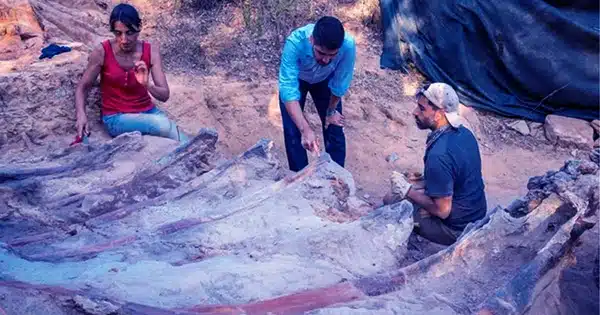A new study describes a new sauropod dinosaur that lived 122 million years ago in the Iberian Peninsula. Garumbatitan morellensis, a new species of dinosaur reported from remains unearthed in Morella (Castelló, Spain), has increased the diversity of dinosaurs known in one of Europe’s greatest Early Cretaceous fossil records.
The sedimentary deposits that arise in the territory of Els Ports de Morella (Spain) contain a plethora of dinosaurs from the Early Cretaceous period, which is around 122 million years old. Some of the first dinosaur fossils unearthed in Spain were discovered in the Morella region in particular. Numerous Mesozoic vertebrate fossils have been discovered in the area around this locality in recent years, some of which are particularly important, including an important collection of ornithopod dinosaurs, including Morelladon beltrani, and sauropod dinosaurs.

This discovery, made by a group of paleontologists from Portugal and Spain, is documented in a paper that has just been published in the prestigious Zoological Journal of the Linnean Society. The new dinosaur species, named Garumbatitan morellensis, is a member of the sauropod family, which includes quadrupedal herbivorous dinosaurs with long necks and tails that may reach massive proportions.
The fossils of this new dinosaur were discovered and excavated in 2005 and 2008 in the Sant Antoni de la Vespa fossil site in the Morella locale. One of the biggest concentrations of sauropod dinosaur remains from the European Lower Cretaceous was located in this deposit, and elements of at least four individuals, three of which belonged to this new species, were identified. Thus, Sant Antoni de la Vespa was an important place for the study of dinosaur faunas in Spain during this time period.
“One of the individuals we discovered is notable for its large size, with vertebrae more than one meter wide and a femur that could grow to be two meters long.” “We discovered two almost complete and articulated feet in this deposit, which is unusual in the geological record,” says Pedro Mocho, the study’s leader and paleontologist from Instituto Dom Luiz, Faculty of Sciences, University of Lisbon (Portugal).
The newly released research provides a detailed description of the fossil remains discovered in Sant Antoni de la Vespa, indicating a set of anatomical features distinct from other sauropod dinosaurs. Garumbatitan is distinguished by the femur’s (the top bone of the leg) and foot components’ distinct morphology. The femur has a morphology similar to that of more recent sauropod femora from the Late Cretaceous.
This study also looks at the kinship links of Garumbatitan morellensis and other sauropod dinosaurs from the Iberian Peninsula’s Early Cretaceous period. Garumbatitan is one of the most primitive members of the Somphospondyli group of sauropods, which was one of the most diversified and prolific groups during the Cretaceous and went extinct at the end of the Mesozoic.
Finally, this study emphasizes the enormous complexity of the evolutionary history of sauropods from the European Cretaceous, particularly those from the Iberian Peninsula, with species related to lineages found in Asia and North America, as well as some groups related to African forms. These findings imply that there were periods of faunal dispersion between these continents.
The eventual restoration of all fossil elements discovered in this deposit will help researchers better understand the early evolution of this group of sauropods, which dominated dinosaur faunas throughout the last million years of the Mesozoic era.
“Our study emphasizes the enormous complexity of the evolutionary history of sauropods from the European Cretaceous—particularly from the Iberian Peninsula, with species related to lineages present in Asia and North America, as well as some groups related to African forms.” “Our findings suggest that there were periods of faunal dispersal between these continents,” Pedro Mocho adds.
“The future restoration of all fossil materials found in this deposit will add important information to understanding the initial evolution of this group of sauropods that dominated dinosaur faunas during the last million years of the Mesozoic era,” says Francisco Ortega, co-author of this study and member of the Grupo de Biologa Evolutiva at the Universidad Nacional de Educación a Distancia (UNED, Spain).
The new species’ name, Garumbatitan morellensis, has two references. On the one hand, Garumbatitan translates as “the giant of Garumba,” as this specimen was discovered near the base of Mola de la Garumba, one of the highest reliefs in the Els Ports region. The specific name Morellensis, on the other hand, relates to the location of the deposit, Morella.
Garumbatitan morellensis fossil remnants are part of one of the most extensive collections of fossil vertebrates from the Iberian Mesozoic, which is housed at the Temps Museum of Dinosaurs in Morella and is part of the Valencian Community Museum Network.















